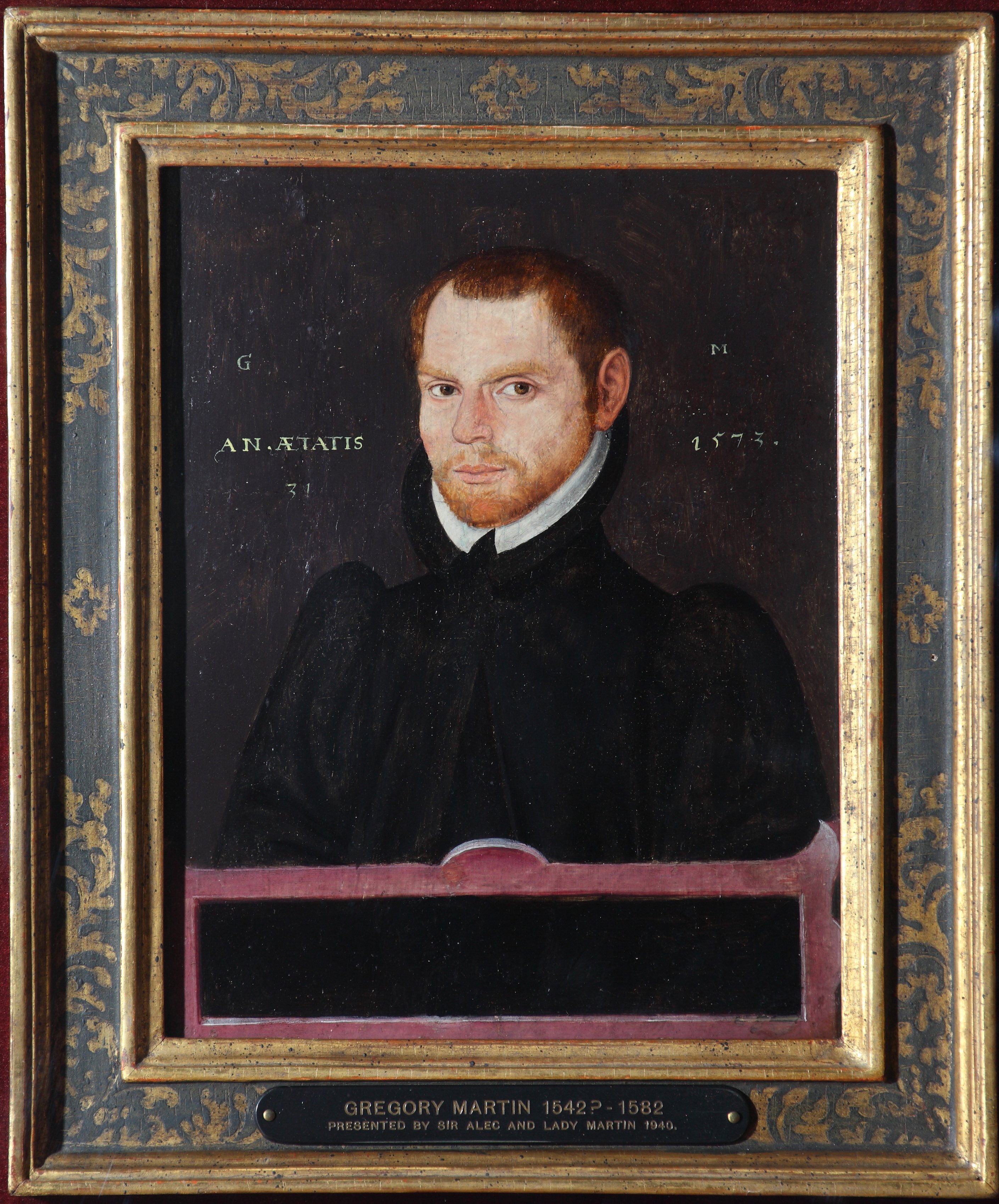8. Portrait of Gregory Martin, by an unknown artist
 Portrait of Gregory Martin (1542?–1582), unknown artist, H 195 x W 145 mm, oil on panel, inscribed and dated 'G M AN.AETATIS/1573/31'. Presented to the College by Sir Alec and Lady Martin through the Art Fund, 1940; purchased by Sir Alec Martin from Lewis & Simmons before 1937
Portrait of Gregory Martin (1542?–1582), unknown artist, H 195 x W 145 mm, oil on panel, inscribed and dated 'G M AN.AETATIS/1573/31'. Presented to the College by Sir Alec and Lady Martin through the Art Fund, 1940; purchased by Sir Alec Martin from Lewis & Simmons before 1937
When encountering a portrait, it is, usually, the gaze of the sitter that engages or deflects or positions the viewer. Our looking becomes subject to the subject, and we enter a matrix of seeing and being seen. This sense of ‘being seen’ is unavoidable in this image, the sixteenth century portrait of Gregory Martin now hanging in the President’s lodgings. The intense gaze of Martin engages the viewer directly, a piercing stare that is complicated and made eerie by the empty cartouche that precedes him spatially but that neither speaks nor wholly contains his dominating presence.
Gregory Martin was one of St John’s original scholars – a contemporary and close acquaintance of the priest and martyr, Edmund Campion. (Martin became the second Fellow in Greek literature at St John’s, and the direct line of fellows thereafter leads to the current tutorial fellow, Dr Emma Greensmith.) A Catholic in the turbulent period of Elizabeth I’s reign, Martin resigned his fellowship in Greek at St John’s in December 1568 and took up a position as a tutor to the sons of the Duke of Norfolk. Within a year, however, the Duke had been arrested on charges of treason (the Catholic education of his children being one of the charges laid against him) and Martin fled to France and a life in exile.
It seems likely that this portrait was made on the occasion of Martin’s ordination to the priesthood in 1573, in Brussels. In her research on this portrait for an exhibition at the National Portrait Gallery, London, Jane Eade established that it was one of several versions and was made from a pattern. This was a common practice at the time; a drawing of the subject was made and then circulated so that a number of portraits could be made with relative ease. A second and contemporary version of this portrait exists in the collection of the Duke of Norfolk at Arundel Castle. It might be that these portraits were made as gifts for family and friends, or that they were circulated in England amongst the supporters of Catholicism. Either way, they were potentially dangerous objects to own.
The face of Martin is thinly painted, and this as well as age allows the under drawing to be seen. The strong lines of the nose speak to the pattern and also add to the confidence of the face. The indications of the beard in the drawing and the ways in which the paint on the beard has been built up speak to the multiple stages of the creation of the painting. The dominating black of the ground and of Martin’s clothing contributes to the startling aspect of the gaze, and also to the problem of the empty cartouche, whose red outline also stands out, and which Martin’s hand all but disappears behind.
This juxtaposition between powerful stare and empty space is poignant. Martin is now mainly remembered for the English translation of the New Testament in the Rheims-Douai Version. Furthermore, five years after this portrait was painted, in 1578, Martin published A Treatise of Schisme in which he examined the difficulties of Catholics in England under Elizabeth I. When a new edition of this was published in 1584, the claim that English Catholics should ‘abstaine from heretical Conventicles’ and that like ‘pious Judith would slay Holofernes’ was interpreted as an incitement to assassinate the queen. Martin still being abroad, the printer, William Carter, was executed. This is not a figure short of words, nor shy of controversy: the gaze speaks to the latter, and, somewhat hauntingly, the empty cartouche to his exile and silencing.
View the painting on Art UK here.
 Dr Jennifer Johnson, Junior Research Fellow in History of Art
Dr Jennifer Johnson, Junior Research Fellow in History of Art